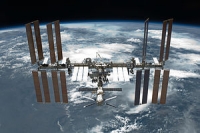The International Space Station (ISS) is a habitable artificial satellite in low Earth orbit. It follows the Salyut, Almaz, Skylab and Mir stations as the ninth space station to be inhabited. The ISS is a modular structure whose first component was launched in 1998. Like many artificial satellites, the station can be seen from Earth with the naked eye. The ISS consists of pressurised modules, external trusses, solar arrays and other elements. ISS components have been launched by American Space Shuttles as well as Russian Proton and Soyuz rockets. Budget constraints led to the merger of three space station projects with the Japanese Kibō module and Canadian robotics. In 1993 the Soviet/Russian Mir-2, the American Freedom, and the European Columbus, merged into a single multi-national programme. The Russian Federal Space Agency plans to separate some of its modules from the Russian segment to form theOPSEK facility before the remainder of the station is deorbited.
The ISS serves as a microgravity and space environment research laboratory in which crew members conduct experiments in biology, human biology, physics, astronomy, meteorology and other fields. The station is suited for the testing of spacecraft systems and equipment required for missions to the Moon and Mars.
The station has been continuously occupied for 11 years and 121 days having exceeded the previous record of almost 10 years (or 3,644 days) held by Mir, in 2010. The station is serviced by Soyuz spacecraft,Progress spacecraft, the Automated Transfer Vehicle, the H-II Transfer Vehicle, and formerly the Space Shuttle. It has been visited by astronauts and cosmonauts from 15 different nations.
The ISS programme is a joint project between five participating space agencies, the American NASA, the Russian RKA, the Japanese JAXA, the European ESA, and the Canadian CSA. The ownership and use of the space station is established by intergovernmental treaties and agreements. The station is divided into two sections, the Russian orbital segment (ROS) and the United States orbital segment(USOS), which is shared by many nations. The ISS is maintained at an orbital altitude of between 330 km (205 mi) and 410 km (255 mi). It completes 15.7 orbits per day. The ISS is expected to remain in operation until at least 2020, and potentially to 2028.








































